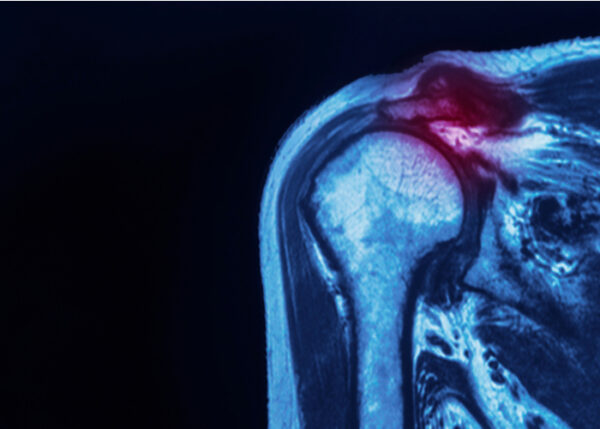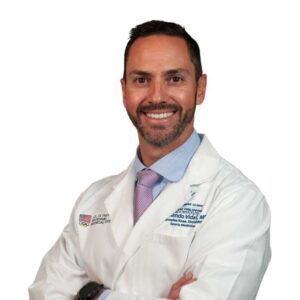What is the Latarjet procedure?
The Latarjet procedure is named after the French surgeon, Dr. Michael Latarjet, who first described the treatment in 1954. Also called the Latarjet-Bristow procedure, it is used to treat shoulder instability and recurrent shoulder dislocations. Oftentimes, shoulder instability is associated with bone loss or fracture of the glenoid (socket portion of the shoulder joint). The Latarjet-Bristow procedure is used to restore the stability of the shoulder joint when bone loss becomes critical. This innovative treatment, offered by Dr. Armando Vidal, orthopedic shoulder surgeon, is becoming the preferred method of treatment for patients in Vail, Aspen and the surrounding Denver, Colorado communities with recurrent shoulder instability with bone loss or revision surgery.

Who is a good candidate for the Latarjet procedure?
The shoulder joint is the most unstable major joint in the body. It is very analogous to balancing a golf ball on a tee. If the tee is chipped on the edge, it can be near impossible to balance the golf ball without it falling off. This is what happens when the shoulder dislocates and creates bone loss on the glenoid (socket). In this situation, the bone loss can become “critical” and the success rate of soft tissue stabilizations and arthroscopic techniques drops significantly. The Latarjet procedure is designed to restore critical bone loss on the glenoid and restore stability and function to an unstable shoulder.
What happens during the Latarjet procedure?
The goal of Latarjet surgery is to recreate a shoulder socket that will hold and support the bones of the shoulder securely. This is done by augmenting the glenoid with additional bone to hold the head of the humerus within the socket of the shoulder. Dr. Vidal obtains the bone augmentation from the coracoid on the scapula (located at the front of the shoulder, on the top).
Latarjet procedure includes the following steps:
- An incision is made in the front of the shoulder.
- Dr. Vidal removes a piece of coracoid bone with the conjoined tendon.
- The coracoid bone is moved to the front of the glenoid (socket.) This new piece of bone will be held in place with metal screws.
- The movement of the coracoid acts as a bone block which prevents further dislocation of the joint by combining with the transferred muscles that act as a strut in the shoulder.
- The conjoined tendon also helps stabilize the shoulder by acting as an internal sling when the shoulder is externally rotated or abducted.
- Placement of the coracoid is critical and needs to be done by a surgeon who has had extensive experience with this procedure.
Why does the Latarjet procedure work for shoulder instability?
The Latarjet procedure accomplishes two important tasks: First, the muscles attached to the coracoid bone piece, when it is relocated, create an internal sling to help support the shoulder in the front of the joint. Second, it increases the amount of bone in the shoulder socket to restore lost or damaged bone, making the socket more secure to hold the humerus. For patients in Vail, Aspen and the surrounding Denver, Colorado communities, the procedure is very successful at restoring stability to the shoulder joint. Dr. Armando Vidal uses the Latarjet procedure as the preferred method of treatment, especially for patients who have worn away at least 20% of the bone in their shoulder socket.
How long does it take to recover after Latarjet surgery?
Ironically, patients with the Latarjet procedure often report that their recovery is faster and easier than an arthroscopic stabilization. The severity of bone loss as well as underlying shoulder damage that also required treatment, along with the patient’s age and activity level, can all have an impact on the recovery process after Latarjet surgery. In general, it takes approximately 4-6 months for the bones to “knit” together and heal. Dr. Vidal’s patients can expect the following after Latarjet surgery:
- Following the repair, a sling will be worn for 5-6 weeks to minimize movement and to protect the joint while it heals.
- Ice can be applied to the incision site to help alleviate pain and swelling.
- Dr. Vidal will prescribe pain medications to be taken as directed.
- The arm will be kept immobile, even when sleeping
- Dr. Vidal will have the patient being a specialized physical therapy program once proper healing has occurred. Passive motion exercises are followed by active range of motion with a very gradual strengthening regimen.
- Return to normal activities can be expected in about 5-6 months.
Shoulder Restoration Surgeon
Have you experienced previous trauma to the shoulder, resulting in instability? If so, you may be a candidate for a Laterjet procedure. Laterjet surgery is a procedure performed to repair the shoulder in cases of instability or bone loss. Arthroscopic shoulder surgeon, Doctor Armando Vidal is an expert on shoulders and can diagnose and perform this procedure for patients in Vail, Aspen, and the surrounding Denver, Colorado communities who are experiencing shoulder instability. Contact Dr. Vidal’s team today!

Locations
180 S Frontage Rd W
Vail, CO 81657
226 Lusher Court
Ste 101
Frisco, CO 80443
322 Beard Creek Road
Edwards, CO 81632


